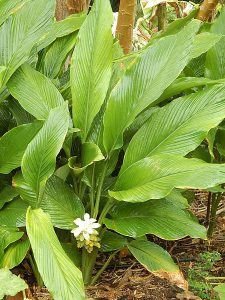
Are you tired of mowing your yard, applying fertilizers and fighting turfgrass pests and diseases?
Many Central Florida residents are seeking more sustainable, low maintenance yards. Lawns planted with turfgrass can be a lot of maintenance, with high inputs of fertilizer and water. Instead of a traditional turfgrass lawn, consider replacing all or part of your yard with an alternative lawn, a wildflower lawn, or a no mow yard filled with groundcovers, shrubs and trees. With careful selection of Florida-Friendly low maintenance plants, you can enjoy your yard and conserve our natural resources. In the photo to the right, Asiatic jasmine and coontie cycads are used for a groundcover, and Simpsons stopper adds some height and provides red berries for birds.
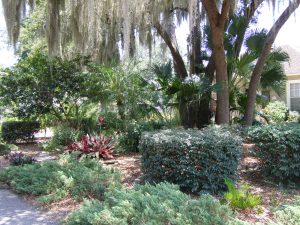
The goal of a no-mow yard is to create a permanent sustainable landscape. The planting scheme can include annuals but should focus more on perennials. Adding biodiversity and having a variety of plants in the landscape can help provide food for wildlife and beneficial insects to help create an ecological landscape that helps to keep garden pests in check by attracting their natural enemies. A landscape with a sustainable Florida-Friendly design with require minimal nutrient inputs with few pest and disease problems.
You can consider doing a larger area in a groundcover or alternative lawn that gets occasionally mowed or trimmed. This yard features a wide groundcover at the front of the yard with black eyed Susan, false rosemary, flax lily, dwarf yaupon holly, and redbud trees. Since this landscape is a little more open and bare you will have more weed issues and the pine straw mulch will need to be replenished at least once a year.
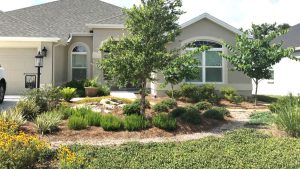
If you are not ready to lose the lawn, simply reduce the amount of turfgrass in your yard. Expanding already existing landscape beds is an easy way to do this. See Florida-Friendly Landscaping Guide to Plant Selection and Landscape Design book for design ideas. Larger landscape beds with shrubs and trees are low maintenance alternatives to turfgrass. Once the trees and shrubs are established, they can survive from rainfall alone and can be self-mulched with the tree leaves.
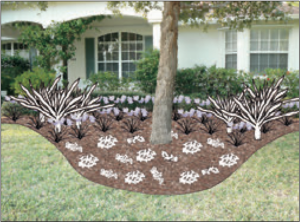
Turfgrass is not all bad, turfgrass is Florida-Friendly, and can provide space for outdoor activities. It is better than concrete because turfgrass can reduce soil erosion, filter pollutants, and reduce surface runoff. However, turfgrass management practices can potentially have negative impacts on the environment from improper fertilization and overwatering. Currently, Orange County, and many other counties in Florida have some type of fertilizer ban in the summer that restricts application of nitrogen and phosphorus in our rainy season from June 1st to Sept 30th. If you do have some portion of your yard covered in turfgrass be sure to care for your lawn properly, see https://gardeningsolutions.ifas.ufl.edu/lawns/. Our FFL research shows most consumers prefer a yard with at least a small strip of turfgrass for aesthetic reasons.
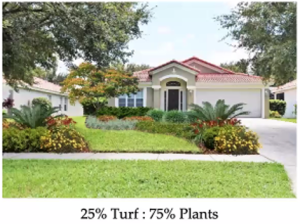
Want to learn more? Check out horticulture classes offered by UF/IFAS Extension Orange County at www.ocextension.eventbrite.com.
Read about Florida-Friendly Landscaping™ https://ffl.ifas.ufl.edu/.
Follow us on Facebook https://www.facebook.com/GardenFlorida/, Instagram https://www.instagram.com/oc_extension/ and visit our website https://sfyl.ifas.ufl.edu/orange/home-lawns-landscapes-and-gardens/florida-friendly-landscaping/.
Source: UF/IFAS Pest Alert



